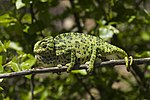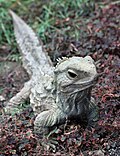fish. Functionally, acrodont tooth implantation may be related to strong bite force. Squamata: Within squamate reptiles, acrodont tooth implantation is...
4 KB (401 words) - 20:13, 22 April 2024
sockets. There are, however, other animals that have acrodont dentition such as tuataras. Usually acrodonts are divided into two families Chamaeleonidae and...
8 KB (664 words) - 14:45, 11 July 2024
front and acrodont posterior teeth. Some rhynchocephalians differ from these conditions, with Ankylosphenodon having superficially acrodont teeth that...
52 KB (5,205 words) - 15:59, 8 August 2024
the rear. Most species are pleurodont, though agamids and chameleons are acrodont. The tongue can be extended outside the mouth, and is often long. In the...
69 KB (6,687 words) - 01:25, 5 September 2024
of bone, as seen in crocodilians, dinosaurs and mammals, and opposed to acrodont and pleurodont dentition seen in squamate reptiles. Notably, this appears...
1 KB (125 words) - 17:02, 30 November 2022
amphibians exhibit teeth that have a slight attachment to the jaw or acrodont teeth. Acrodont teeth exhibit limited connection to the dentary and have little...
42 KB (5,021 words) - 05:16, 26 August 2024
chameleons and agamids. Modern acrodontans are characterized by their acrodont dentition, meaning that their teeth implant along the margins of the jaws...
6 KB (660 words) - 20:03, 21 January 2024
lizard to glide. While in its original description it was considered to acrodont lizard, with a cladistic analysis in the same study suggesting that it...
7 KB (643 words) - 21:31, 3 August 2024
agamids is their teeth, which are borne on the outer rim of their mouths (acrodonts), rather than on the inner side of their jaws (pleurodonts). This feature...
15 KB (1,646 words) - 02:17, 20 August 2024
surface of the jaw. The four following pairs of teeth are much smaller and acrodont, meaning that they grow from the upper margin of the jaw. Behind them are...
2 KB (175 words) - 01:19, 29 October 2021
individual sockets (like in thecodonty) or without bone encasement (like in acrodonts and pleurodonts). It is known from several aquatic amniotes: ichthyosaurs...
1 KB (127 words) - 02:43, 11 September 2024
but is not found among the non-archosaur reptiles, which instead have acrodont or pleurodont dentition. Teeth that were lost were replaced by teeth below...
39 KB (3,637 words) - 12:48, 12 September 2024
attached to the inner side of the jaw along with larger posterior triangular acrodont teeth attached to the apex of the jaw bone, similar to other primitive...
4 KB (330 words) - 21:52, 25 April 2024
suborder Iguania Acrodonta (katydid), a katydid genus in the tribe Agraeciini Acrodont, a formation of the teeth whereby the teeth are consolidated with the summit...
361 bytes (77 words) - 19:08, 2 March 2022
the tuatara, and almost all other rhynchocephalians, are described as acrodont, as they are attached to the apex of the jaw bone. This contrast with the...
87 KB (9,276 words) - 10:20, 19 August 2024
J. (2000-04-01). "Evaluating Trans-Tethys Migration: An Example Using Acrodont Lizard Phylogenetics" (PDF). Systematic Biology. 49 (2): 233–256. doi:10...
31 KB (3,530 words) - 18:07, 7 June 2024
between the eyes, the interorbital septum, is present. Its dentition is acrodont; the teeth are compressed, triangular, and more or less distinctly tricuspid...
7 KB (890 words) - 15:50, 13 February 2024
name, which means "Phrynosoma mimic." Like other priscagamids it has an acrodont dentition, meaning that its teeth grow from the margins of the jaws rather...
2 KB (169 words) - 12:35, 14 March 2023
area and simple mono-cuspid teeth rostrally. Chameleon teeth are also acrodont ankylosed to the bones of the jaw. Odontoblasts produce a layer of predentin...
34 KB (4,236 words) - 19:43, 6 September 2024
jaws and 11 larger permanent acrodont teeth in the posterior jaws. It was likely an insectivore which used its acrodont posterior teeth to dismember prey...
7 KB (607 words) - 21:58, 22 March 2024
crassus Bayn Dzak, Ukhaa Tolgod, Zos Wash "Partially complete skulls." An acrodont. Also present in the Bayan Mandahu Formation. Myrmecodaptria M. microphagosa...
93 KB (7,022 words) - 19:51, 17 September 2024
member of Sphenodontidae. Like most other rhynchocephalians, the teeth are acrodont, with a deep dentary, and it probably had an omnivorous habit. Apesteguía...
4 KB (381 words) - 16:51, 29 July 2024
an elongated premaxillary process) and eusphenodontian characters (full acrodont dentition, high coronoid process and anterior successional teeth, including...
3 KB (261 words) - 11:56, 23 March 2024
Kota Formation of India. The type specimen is a partial jawbone which has acrodont teeth, with other known remains including fragments of the premaxilla,...
4 KB (209 words) - 16:57, 13 June 2024
be damage to the fossil. They agreed with Sharov that Longisquama has acrodont teeth and an interclavicle, but instead of a furcula, they saw paired clavicles...
16 KB (1,815 words) - 17:45, 27 July 2024
reptiles and theropod dinosaur fossils have an interdental plate, whereas acrodont reptiles such as Sphenodontia do not. Its presence in Archaeopteryx, an...
3 KB (309 words) - 15:48, 10 November 2023
in some adult individuals. While initially suggested to have had fully acrodont dentition, later X-ray analysis suggested that the teeth at the front of...
7 KB (614 words) - 21:54, 1 May 2024
iguanians called Acrodonta, members of which are characterized by an "acrodont" dentition in which the teeth grow from the margins of the jaws. However...
2 KB (235 words) - 11:55, 3 March 2021
agamids and are currently restricted to the Old World. Gueragama is the only acrodont known from South America, providing evidence that the group once ranged...
4 KB (395 words) - 17:24, 25 April 2024
where the teeth are fused to the inner sides of the jaw bones, or the acrodont dentition, in which the teeth are fused to the top of the jaw bones without...
160 KB (16,550 words) - 01:59, 22 August 2024


















